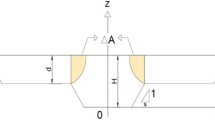Abstract
A new method is proposed to calculate flow in a compound meandering channel by considering the momentum transfer between different zones. Vertical momentum transfer, at the horizontal interface of the lower main channel and the meander belt; and the horizontal momentum transfer, at the vertical interfaces between the meander belt and the adjoining outer floodplains. Modelling of this analytical method for the bend apex section is carried out, for a control volume of unit length. Calibration has been carried out for different laboratory channels and a natural river, demonstrating that the present model is capable of providing an adequate prediction of discharge in experimental as well as in field study. A constant value of 0.01 as the momentum transfer coefficient is verified to act at the interacting interfaces for the meandering channels. The zonal velocity for each subsection is determined, which facilitates prediction of discharge distribution.









Similar content being viewed by others
References
Bousmar D, Zech Y (1999) Momentum transfer for practical flow computation in compound channels. J Hydraul Eng 125(July):696–706
Chow VT (1959) Open-channel hydraulics. McGraw-Hill, New York
Ervine DA, Ellis J (1987) Experimental and computational aspects of overbank floodplain flow. In: Transactions of the Royal Society of Edinburgh. Cambridge University Press, Earth Sciences
Ervine DA, Willetts BB, Sellin RHJ, Lorena M (1993) Factors affecting conveyance in meandering compound flows. J Hydraul Eng 119(12):1383–1399
Greenhill RK, Sellin RHJ (1993) Development of a simple method to predict discharge in compound meandering channels. Proceedings of the Institution of Civil Engineers - Water Maritime and Energy 101(1):37–44
Huai W, Xu Z, Yang Z, Zeng Y (2008) Two dimensional analytical solution for a partially vegetated compound channel flow. Appl Math Mech 29(8):1077–1084
James, C. S., and Wark, J. B. (1992). Conveyance estimation for meandering channels
Jansen P (1979) Principles of river engineering. Pitman, London
Jing H, Guo Y, Li C, Zhang J (2009) Three-dimensional numerical simulation of compound meandering open channel flow by the Reynolds stress model. Int J Numer Methods Fluids 59(8):927–943
Lambert MF, Myers WRC (1998) Estimating the discharge capacity in straight compound channels. Proceedings of the Institution of Civil Engineers, Water, Maritime and Energy 130(11530):84–94
Liu C, Wright N, Liu X, Yang K (2014) An analytical model for lateral depth-averaged velocity distributions along a meander in curved compound channels. Adv Water Resour 74:26–43
Liu C, Shan Y, Liu X, and Yang K (2015). Method for assessing discharge in meandering compound channels. Proceedings of the Institution of Civil Engineers-Water Management, 17–29
Morvan H, Pender G, Wright NG, Ervine DA (2002) Three dimensional hydrodynamics of meandering compound channels. J Hydraul Eng 128(7):674–682
Myers WRC (1978) Momentum transfer in a compound channel. Journal of Hydraulic Research, Taylor & Francis 16(2):139–150
O’Sullivan JJ, Myers R, Lyness JF, Lambert MF (2003) Discharge assessment in mobile-bed compound meandering channels. Proceedings of Institution of Civil Engineers, Water, Maritime & Energy 156(WM4):313–324
Patra KC, Kar SK (2000) Flow interaction of Meandering River with floodplains. Journal of Hydraulic Engineering, American Society of Civil Engineers 126(8):593–604
Rameshwaran P, Shiono K (2007) Quasi two-dimensional model for straight overbank flows through emergent. J Hydraul Res 45(3):302–315
Rozovski\u\i IL (1957). Flow of water in bends of open channels. Academy of Sciences of the Ukrainian SSR
Schlichting H (1968). Boundary Layer Theory. McGraw Hill
Sellin RHJ (1964) A laboratory investigation into the interaction between the flow in the channel of a river and that over its flood plain. La Houille Blanche (7):793–802
Sellin, R. H. J., Giles, A., and van Beesten, D. P. (1990). “Post-implementation appraisal of a two-Stage Channel in the river Roding, Essex.” Water and Environment Journal, Blackwell Publishing Ltd, 4(2), 119–130
Sellin RHJ, Ervine DA, Willetts BB (1993) Behaviour of meandering two-stage channels. Proceedings of the Institution of Civil Engineers-Water Maritime and Energy 101(2):99–111
Shiono K, Muto Y (1998) Complex flow mechanisms in compound meandering channels with overbank flow. J Fluid Mech 376:221–261
Shiono K, Al-Romaih JS, Knight DW (1999) Stage-Discharge Assessment in Compound Meandering Channels. J Hydraul Eng 125(1):66–77
Shiono K, Chan TL, Spooner J, Rameshwaran P, Chandler JH (2009) The effect of floodplain roughness on flow structures, bedforms and sediment transport rates in meandering channels with overbank flows: part I. J Hydraul Res 47(1):5–19
Spooner J, Shiono K (2003) Modelling of meandering channels for overbank flow. Water & Maritime Engineering 156(WM3):225–233
Toebes GH, Sooky AA (1967) Hydraulics of meandering rivers with flood plains. Journal of the Waterways and Harbors Division 93(2):213–236
US Army, C. of E (1956). “Hydraulic capacity of meandering channels in straight floodways.” Waterways Experiment Station, Vicksburg, Mississippi
Willetts BB, Hardwick RI (1993) Stage dependency for overbank flow in meandering channels. Proc Inst Civ Eng Water Marit Energy 101:45–54
Wormleaton PR (1996). Floodplain secondary circulation as a mechanism for flow and shear stress redistribution in straight compound channels. Coherent flow structures in open channels
Wormleaton PR, Allen J, Hadjipanos P (1982) Discharge assessment in compound channel flow. Journal of the Hydraulics Division, American Society of Civil Engineers 108(9):975–994
Yang K, Liu X, Cao S, Huang E (2013) Stage-discharge prediction in compound channels. J Hydraul Eng 140(4):6014001
Author information
Authors and Affiliations
Corresponding author
Ethics declarations
Conflict of Interest
None.
Additional information
Publisher’s Note
Springer Nature remains neutral with regard to jurisdictional claims in published maps and institutional affiliations.
Rights and permissions
About this article
Cite this article
Pradhan, A., Khatua, K.K. Discharge Estimation at the Apex of Compound Meandering Channels. Water Resour Manage 33, 3469–3483 (2019). https://doi.org/10.1007/s11269-019-02309-5
Received:
Accepted:
Published:
Issue Date:
DOI: https://doi.org/10.1007/s11269-019-02309-5




